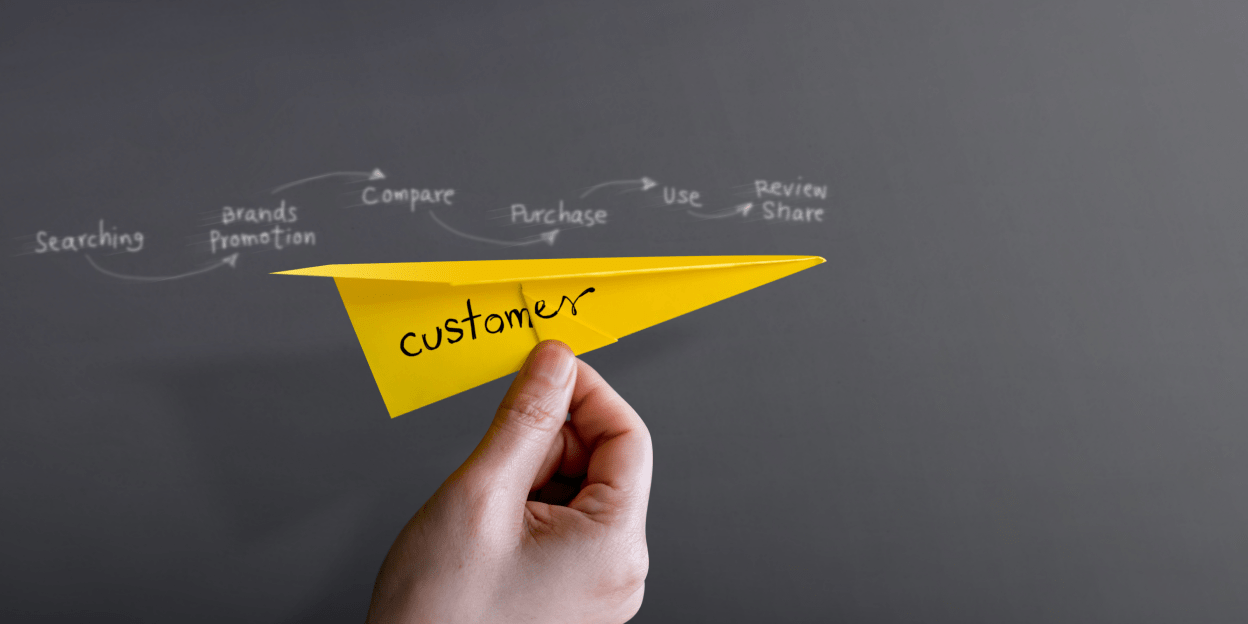A customer touchpoint is every moment a customer encounters your business. Every interaction they have with your brand is a touchpoint, even if it's not a physical interaction. You find them at every stage in the customer journey, and they can significantly impact how customers feel about your business.
There are endless customer touchpoints that are critical to your business, and they can impact customer loyalty, sales, and lifetime value.
Customer touchpoints and the customer journey
Customer touchpoints can be collated and used to create a touchpoint map. This differs from the customer journey, which looks at how customers transition from one touchpoint to another and the steps they take to become paying customers.
Examples of touchpoints include a customer scrolling through social media and seeing your posts, receiving a text message to inform them their order is out for delivery, or visiting a physical store, but in most cases, a customer will not experience every single touchpoint. A customer's journey will usually be made up of a select few touchpoints, and each customer will experience a different customer journey as they come across varying touchpoints and have different interactions with your brand.
If you're looking at creating a map for your customer touch points, there are lots of examples and templates online that you can take advantage of - Miro has a good one, and there's a great explanation of the difference between the customer journey and the buyer's journey on Hubspot.
What's the difference between a customer touchpoint and a channel?
Customer experience touchpoints and channels are both essential elements within a customer journey. A touchpoint is when a customer interacts with your business, for example, watching a product demonstration, completing a website form or booking a table in a restaurant. A channel is the environment in which a customer touchpoint happens. This could include your website, a social media channel, or an advertising leaflet.
Why optimising customer touchpoints online is beneficial for businesses
Customer touchpoints play a crucial role in defining the experience for your customers. Knowing what your touchpoints are can help you improve them and identify areas where you might be missing out on business opportunities.
How consumers shop and interact with businesses has changed dramatically over the years. For example, 15 years ago, the average customer would use just two touchpoints when making a purchase, with just 7% of consumers using over four touchpoints. Today, customers are using an average of 5 - 6 touchpoints.
This increase is primarily due to technological advances, which have provided consumers with more ways to interact with a business. Having effective customer touchpoints can not only improve sales but can also boost customer loyalty. Retaining an existing customer is more valuable than acquiring a new one, and those customer touchpoints can help.
Customer touchpoints - where are they?
Before you can work to improve your customer touchpoints, you first need to identify which touchpoints your business has. When you set out to improve the customer experience for your retail business, you will locate several touchpoints critical to success. Here, we outline some of the key customer touchpoints and how to use them to improve your customer experience:
Website
To improve customer experience, your first stop should be your website, as your company's site will act as a hub for many customer touchpoints. Your website is the central focus of your brand and identity, and it needs to project this to your audience accurately. Consider your eCommerce site's functional and visual capability and review it consistently to ensure you are keeping up with the latest customer demands. For example, 79% of smartphone users made a purchase on their mobile in the last six months, so optimizing for mobile is vital.
Email has one of the highest ROIs of all the marketing channels, so while it might be a classic, email marketing is still a significant customer touchpoint. Email marketing is a proven strategy for converting browsers into buyers, and when looking to improve CX, you should always consider your current email marketing tactics. Remember, customers receive a massive number of emails every day, so it is essential that your marketing messages stand out from the competition. To improve CX, focus on email marketing campaigns that add value to your customers' lives.
Chatbot
The number of chatbots installed on websites has increased dramatically in recent years, with more and more retail businesses adopting this technology. Most chatbots use artificial intelligence, or AI, to improve customer experience and streamline the customer journey. They are a critical touchpoint that can help convert customers from browsing your site to making a purchase. If you do not already have a chatbot, investing in one is an easy and effective way to improve CX.
Customer support
Customer support is among the most popular customer touchpoints in eCommerce and physical commerce. Customer support is the bedrock of CX in retail, finance, health and any sector you can think of, so ensuring you are giving customers everything they need is vital. Whether it is a real-time chat assistant online or a call center, improving customer support will dramatically improve customer experience.
Voice assistant
This is a rapidly developing customer touchpoint, with customers increasingly turning to Alexa, Google Assistant and Siri when purchasing. Optimizing your website for voice search and preparing your business for a rise in this channel will help improve customer experience.
Text message (SMS)
With an open rate of 98%, text messages are a powerful customer touchpoint. While many retail businesses have yet to use SMS as a marketing channel, incorporating this into your strategy can be very effective.
Social media
Social media is another channel that offers many different customer touchpoints. With social channels constantly introducing new features, it is a constantly evolving part of the customer journey. To improve CX for your retail business, make sure you are using social media effectively and efficiently.
Influencers
Online influencers can work as customer touchpoints and improve customer experience by establishing trust for your brand. Influencers can reach a very large, very targeted audience, and utilizing them in your marketing can be very beneficial.
Customer touchpoint examples can provide helpful insight into the common touchpoints that most businesses will have. Outside of those listed above, there are other customer touchpoints that can be categorised into pre-purchase, during-purchase, and post-purchase touchpoints.
Pre-purchase touchpoints
- Online advertising, including display advertising, pay-per-click (PPC) and social media adverts
- Digital marketing, including blogs, infographics and promotional videos
- Word of mouth, including referrals from friends and family.
During-purchase touchpoints
- Conversations, including those in-store or at an event
- Product pages
- Reviews, including review platforms and on-page reviews
- Point of Sale (POS), including merchandising in-store or speaking with a sales representative
Post-purchase touchpoints
- Feedback surveys
- Thank you emails, including handwritten notes sent with products
- Loyalty programs, including exclusive discounts and offers
- Billing, as a negative billing experience could deter customers and result in negative feedback.
How to identify customer touchpoints
Your business will have a unique set of customer touchpoints. If you have touchpoints you're unaware of, you could miss out on revenue by failing to capitalize on these interactions. Here are some steps you can take to identify your customer touchpoints:
Put yourself in your customers' shoes
The most effective way to identify your customer touchpoints is to put yourself in their shoes. Ask yourself what you would do if you were looking to solve a problem or needed to make a purchase decision about your products. Put yourself on your customer journey and make a note of every touchpoint you find along the way.
Follow this process until you've completed a purchase. You can align your thoughts on customer touchpoints for your business with feedback from existing customers. Reviews and surveys can help you to understand consumers' real-life experiences with your business.
Map your customer journey and customer experience
A customer journey map is essential because it outlines all the touchpoints a customer could experience while interacting with your business. Take it one step further by creating a customer experience map, which will analyze every aspect of customer experience with your brand and highlight multiple touchpoints.
Customer journey and customer experience maps are both helpful in identifying customer touchpoints. A journey map is best for focusing on a specific path a customer might take and the touchpoints they encounter. A customer experience map can help you visualize every customer journey and better understand how customers interact with your business.
Categorise your touchpoints
Once you've identified your customer touchpoints, categorize them so that you can better understand the customer experience. Typically, touchpoints will fall into one of four categories:
Products: These include software, hardware and services. Depending on your business, your website might fall into this category because it may be a part of your product or service.
Interactions: Any customer touchpoint that is a two-way interaction should fall under the interactions category. This could be online (such as live chat), on the phone, or in person.
Settings: These are places where your products or services might be seen or used by customers, for example, in-store, at an event or on TV.
Messages: Any one-way communication is a message touchpoint. This could be advertising, product packaging, or any touchpoint where you communicate with customers but where they cannot communicate back.
How to improve customer touchpoints?
There is no hard and fast rule to improve your customer touchpoints. Instead, once you have collated a list of the most commonly used touchpoints for your business, you will need to go through and review how you can improve the customer experience and devise a strategy to make the necessary changes.
For example, if someone requests more information on a product through social media and nobody replies, get a process in place where all messages are acknowledged within 24 hours.
When it comes to reviews, that's where we can help. With 93% of consumers reading reviews before making a purchase, Feefo's focus on verified reviews can ensure that customer touchpoint is taken care of, from collecting and displaying your reviews to responding to and analyzing them.

.png)

